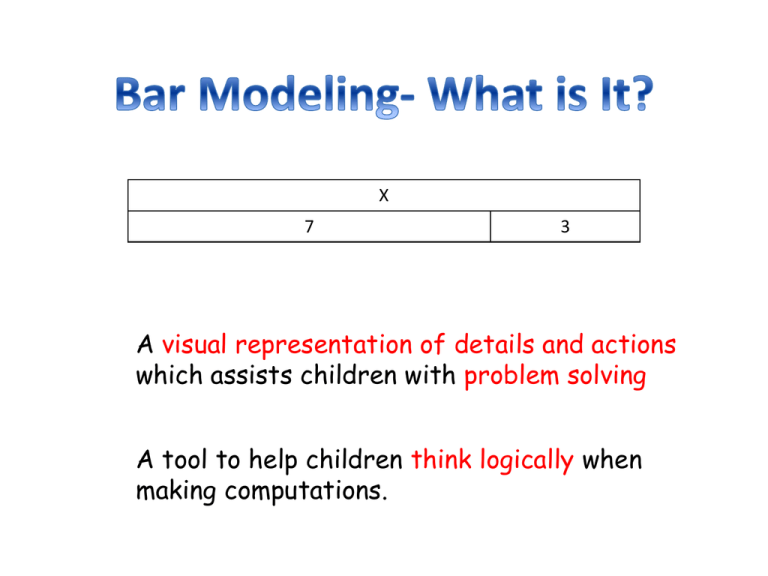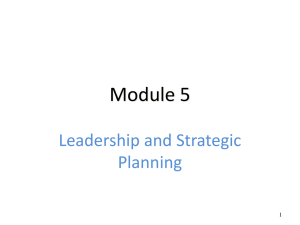Bar Modeling- Addition and Subtraction
advertisement

X 7 3 A visual representation of details and actions which assists children with problem solving A tool to help children think logically when making computations. • Part/Part/Total diagrams are not proportional • PPT diagrams do not reinforce problem solving or number relationships Ted has 6 toys. Mary has 2 toys. How many toys do they have altogether? T 6 2 •When the parts are not represented in proportion, student do not reinforce the relationship between the numbers. • Bar models foster number sense because bars are proportional and have meaning 10 8 2 10 4 6 Let’s consider the same problem with bar modeling… • Fred has 6 toys. Mary has 2 toys. How many toys do they have altogether? T 6 2 Like the Part/Part/Whole diagram, the bar model allows the students to put parts together to get the total number of toys, but the bar model • reinforces the notion that Ted has more than Mary. • requires students to be more thoughtful about where to put the numbers • It also allows for further exploration… •How many more does Ted have than Mary? •How many could Ted give Mary so they could have the same, etc…. Number Model: _____________+_____________=_____________ _____________=_____________+_____________ Number Model: _____________+_____________=_____________ _____________=_____________+_____________ Bar Modeling Number Model: _____________+_____________=_____________ _____________=_____________+_____________ • Fred has 6 toys. Mary has 2 toys. How many toys do they have altogether? T 6 2 T is the same as 6+2 T=6+2 T=8 There are 8 toys altogether. *Since the parts are the same size as the whole, it reinforces that equal means ‘same as’. As bar models get more complicated, the bar models will continue to provide a visual for the algebraic relationships • Have you ever had students add when they should subtract? – John collects rocks. He started with 4. After his vacation, he had 10. How many rocks did he collect on vacation? Beginning Addition Part Subtraction Total Change Add (join) a Part Subtract (separate) a Part End Total Part Number Model: _____________+_____________=_____________ Start Change + End = 4 butterflies were sitting on a branch. 2 more landed on the branch. How many butterflies were on the branch now? Number Model: 4+2=6 • Change problems can be presented in different ways so… • Bar Models will help students to: – Think about what information they have been given and what information they will are being asked to figure out. Addition (Change) Beginning Change End Part Add (join) a Part Total B* 2 6 4 B* 6 2 4 B * May require subtracting or ‘counting up’. The bar model will help students choose what to do. Total Amount Unknown R 8 2 Amount Joined Unknown 10 2 •8+2=R •John has $2 in his piggy bank. He needs $10 to buy the new toy he wants. How much more does he need to save to have enough money? •2+D=10 D Initial Amount Unknown 10 B # Story •The team had 8 runs. They scored 2 more. How many do they have in all? 5 •Mary added 5 books to her library. Now she has 10 books in her library. How many books did she start with? •B+5=10 Total Amount Unknown Picture Amount Joined Unknown Picture Initial Amount Unknown Picture Total Amount Unknown Number Model Amount Joined Unknown Number Model Initial Amount Unknown Number Model Bar Modeling- Subtraction-Change Number Model: _____________-_____________=_____________ Start Change - End = There were 4 butterflies sitting on a branch. 2 flew away. How many were left? Bar Modeling- Subtraction-Change Number Model: 5-2=3 • Change problems can be presented in different ways so… • Bar Models will help students to: – Think about what information they have been given and what information they will are being asked to figure out. Subtraction (Change) Beginning Total 5 5 B* Change Subtract (separate) a Part B 2 2 * May requires adding. . The bar model will help students choose what to do. End Part 3 B 3 Amount Remaining Unknown 10 8 x Amount Separated Unknown 10 x # Story •Suzie had $10. She spent $8 on lunch. How much money does she have left over? •10-8=x •John had to read 10 books over the summer. He only has 2 left to read. How many books did he read? •10-x=8 8 Initial Amount Unknown x 5 •Jim ate 5 cookies out of the box. He only has 5 left. How many were in the box? •X-5=5 5 Amount Remaining Unknown Picture Amount Separated Unknown Picture Initial Amount Unknown Picture Amount Remaining Unknown Number Model Amount Separated Unknown Number Model Initial Amount Unknown Number Model Bar Modeling- Part/Part Whole Number Model: _____________+_____________=_____________ _____________-_____________=______________ 1st Part 2nd Part + End = There were 4 butterflies and 2 ladybugs sitting on a branch. How many insects were sitting on the branch? Bar Modeling-Part/Part/Whole Number Model: 4+2=6 6-4=2 6-2=4 • Part/Part/Whole problems can be presented in different ways so… • Bar Models will help students to: – Think about what information they have been given and what information they will are being asked to figure out. 1st Part 2nd Part Addition (Part/Part/Whole) Subtraction (Part/Part/Whole) I I Whole I Whole Unknown F 2 8 •F=2+8 First Part Unknown 10 S 2 Second Part Unknown 10 5 # Story •There were 2 apples and 8 bananas in the fruit bowl? How many pieces of fruit were in the bowl? x •Jim had 10 brothers and sisters. How many sisters did he have if head 2 brothers? •10=s+2 •Jim had 10 brothers and sisters. If he had 5 brothers, how many sisters did he have? •10=5+B Whole Unknown Picture First Part Unknown Picture Second Part Unknown Picture Whole Unknown Number Model First Part Unknown Number Model Second Part Unknown Number Model • There are 3 types of addition/subtraction problems: change, part/part/whole and comparison. • Change and part/part whole problems are based on the concepts of parts building wholes. COMPARISON PROBLEMS DO NOT! • COMPARISON PROBLEMS ARE BASED ON FINDING THE DIFFERENCE BETWEEN TWO PARTS Bar Modeling- Multiplication Number Model: _________-__________=_________ (more or less) Larger Amount Smaller Amount - = Jim has 5 butterflies. Mary has 2. How many more butterflies does Jim have than Mary? Number Model: 5-2=3 • Comparison problems can be presented in different ways so… • Bar Models will help students to: – Think about what information they have been given and what information they will are being asked to figure out. Larger Amount Subtraction (Comparison) Addition (Comparison) Smaller Amount Amount more or Less Unknown (Difference) B B B * May require adding. Bar Models will help students figure out what to do. Amount More (or Less) Unknown 10 c 4 Difference Smaller Amount Unknown 10 # Story •Ted has 10 crayons. Neil has 4 crayons. •How many more crayons does Ted have than Neil? •How many fewer crayons does Neil have than Ted? •10-4=c •Ted had 10 crayons. Neil has 6 less than Ted. How many crayons does Neil have? •10-6=c 6 Difference c Larger Part Unknown c 5 5 Difference •Ted Has 5 crayons. Neil has 5 more than Ted. How many crayons does Neil have? •5+5=c Picture Picture Picture Number Model Number Model Number Model Multiplication Bar Modeling Number Model: _____________x_____________=_____________ Bar Modeling- Multiplication Number Model: _____________x_____________=_____________ Start Join X = Jim collects butterflies. There were 3 butterflies in each container. He had 2 containers. How many butterflies does Jim have in his collection? Number Model: 6÷2=3 • Multiplication can be presented in different ways so… • Bar Models will help students to: – Think about what information they have been given and what information they will are being asked to figure out. Total # of Parts Amount Per Part 6 6 B B* 2 2 3 B* 3 * May require dividing. . The bar model will help students choose what to do. Total Amount Unknown e 1 2 1 2 1 2 1 2 1 2 Example •Ted has 5 cartons of eggs. Each carton has 12 eggs in it. How many eggs does Ted have? •E=12x5 Amount Per Group Unknown 36 A A A A Example •Ted bought 4 bags of apples. Altogether, there were 36 apples. How many apples were in each bag? •4xA=36 # of Groups Unknown 40 8 B Picture Ted bought $40 worth of books for his friends. Each book cost $8. How many books did he buy? 40=Bx8 Total Amount Unknown Picture Amount Per Group Unknown Picture # of Groups Unknown Picture Total Amount Unknown Number Model Amount Per Group Unknown Number Model # of Groups Unknown Number Model Bar Modeling- Division Number Model: _____________÷_____________=_____________ Start Separate End ÷ = Jim caught 6 butterflies. She placed them in 2 containers. How many were in each container Division Number Model: 6÷2=3 • Division can be presented in different ways so… • Bar Models will help students to: – Think about what information they have been given and what information they will are being asked to figure out. Total # of Parts Amount Per Part 5 6 B* B 2 2 3 B 3 * May require adding. . The bar model will help students choose what to do. Amount Per Group Unknown Example •Ted has 60 eggs. 36 •E=12x5 e e e e e Amount Per Group Unknown 36 A A A A Example •Ted has 36 apples. He put them into 4 bags. How many apples did he put in each bag? •36=4xA # of Groups Unknown 40 8 B Picture Ted bought $40 worth of books for his friends. Each book cost $8. How many books did he buy? 40=Bx8 Amount Per Group Unknown Example •Ted has 60 eggs. 36 •E=12x5 e e e e e Amount Per Group Unknown 36 A A A A Example •Ted has 36 apples. He put them into 4 bags. How many apples did he put in each bag? •36=4xA # of Groups Unknown 40 8 B Picture Ted bought $40 worth of books for his friends. Each book cost $8. How many books did he buy? 40=Bx8 Total Amount Unknown Picture Amount Per Group Unknown Picture # of Groups Unknown Picture Total Amount Unknown Number Model Amount Per Group Unknown Number Model # of Groups Unknown Number Model • Visual representation of details and actions which assists children with problem solving • Helps children logically think using visual models to determine their computations • Fosters number sense because numbers are represented proportionally • Teaches the importance of language within math problems • Provides foundation for algebraic understanding • Provides for differentiated instruction • Empowers students to think systematically and master more difficult problems • Makes multi-step and multi-concept problems easy to work • Work on every problem • Specify ONE RIGHT model • Specify ONE RIGHT operation






